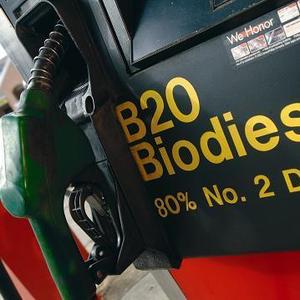Nat'l Biodiesel Board launches promotional advertising campaign

June 16, 2016
BY The National Biodiesel Board
The National Biodiesel Board announced June 16 that the advanced biofuel industry trade group has launched a promotional media campaign for the fifth straight year. With a theme of “More is Less,” the ads illustrate that Americans can significantly reduce carbon emissions and other pollution by using more biodiesel in vehicles and fleets.
“Using more biodiesel means less fossil fuel, less carbon emissions, less carcinogens, less environmental impact,” said Donnell Rehagen, NBB’s chief operation officer and interim CEO. “Even if you don’t drive a diesel vehicle or operate heavy machinery, we are showing consumers that biodiesel is working for you, cleaning the air and improving the environment.”
According to the 2016 Fleet Purchasing Outlook study conducted by NTEA—the association for the work truck industry—biodiesel is now the most commonly used alternative fuel option on the market. Survey data show 18 percent of fleets use biodiesel now—up from 15 percent in 2015. And in terms of future alternative fuel interest, biodiesel also took top honors, with more fleets planning to acquire or continue using biodiesel than any other alternative fuel option. The increased demand comes as the U.S. EPA and California Air Resources Board have affirmed that biodiesel ranks among the lowest carbon fuels on the market and reduces greenhouse gas emissions by as much as 80 percent or more compared with petroleum diesel.
Advertisement
Produced by PCI Communications, the 30-second television commercial features Medford Township (New Jersey) Public School buses weaving their way through town while a narrator explains the district’s history with biodiesel. In May, EPA presented Medford with the 2016 Environmental Champion Award at a ceremony in New York City. The award honors Medford’s outstanding commitment to protecting and enhancing environmental quality and public health. Medford’s leadership in the use of biodiesel alone has eliminated 123,376 pounds of smog-forming emissions, 2,408 pounds of diesel particulate matter and reduced its fleet operation costs by over $170,000.
The 2016 NBB campaign also includes a new website at a familiar address: AmericasAdvancedBiofuel.com. There, visitors can view vignettes on prominent biodiesel users from across the country, including:
-City of New York: In 2013, New York City planned for their 9,000 diesel-powered municipal fleet vehicles to biodiesel blends. It began with the parks department, which found compliance so easy it soon upped its biodiesel use to B20 in its vehicles. Other departments followed suit, including the sanitation department, which began using biodiesel in all of its fleet vehicles. With sanitation consuming 80 percent of New York City’s fleet fuel, its move to biodiesel has paid dividends. The city has experienced a 19 percent reduction in carbon emissions since 2005, on track to reaching an 80 percent reduction by 2050.
-Salt River Project, electricity provider to the Phoenix metropolitan area: Biodiesel provides power for more than 900 of the company’s vehicles. Since its biodiesel pilot program began in 1999, SRP has converted 41 percent of its fleet to B20. Of its nearly 2,300 vehicles, 950 run on biodiesel. By using more B20 in its fleet, SRP has saved money and upheld its environmental stewardship.
Advertisement
In addition to the stories of biodiesel use from local enthusiasts, visitors to the website are invited to learn more about biodiesel and even take a fun quiz to “Test Your Bio-Q.”
Made from an increasingly diverse mix of resources such as soybean oil, recycled cooking oil and animal fats, biodiesel is a renewable, clean-burning diesel replacement that can be used in existing diesel engines. It is the first and only commercial-scale fuel produced across the U.S. to meet the EPA’s definition as an advanced biofuel—meaning the EPA has determined that biodiesel reduces greenhouse gas emissions by at least 50 percent when compared with petroleum diesel. According to the EPA, biodiesel’s reduction ranges from 57 percent to 86 percent depending on how it’s made.
Last year the 2 billion gallon biodiesel market cut carbon by some 18 million metric tons—the annual greenhouse gas emissions of 3.8 million cars.
Related Stories
Airbus is taking a significant step toward scaling the adoption of sustainable aviation fuel (SAF) by testing a new “Book and Claim” approach. This initiative aims to boost both supply and demand for SAF worldwide.
Signature Aviation, the world’s largest network of private aviation terminals, has announced the expansion of its blended SAF offering at six new locations across Europe following multiple blended SAF supply agreements.
Virgin Australia has entered an agreement with Viva Energy to SAF for its flights departing from Proserpine, Queensland. The SAF will consist of Jet A1 and a 30-40% synthetic blend component made from waste and residue feedstocks.
The largest single volume order of sustainable aviation fuel (SAF) by a DB Schenker customer has been placed by Mercedes-Benz. The order is for approximately 13,000 metric tons of SAF and is expected to reduce CO2 emissions by 40,000 metric tons.
ADM and Loyola University Chicago Searle Biodiesel Lab have joined the expanding B20 Club. Founded in 2014, the B20 Club is a partnership between the Illinois Soybean Association and American Lung Association.
Upcoming Events










